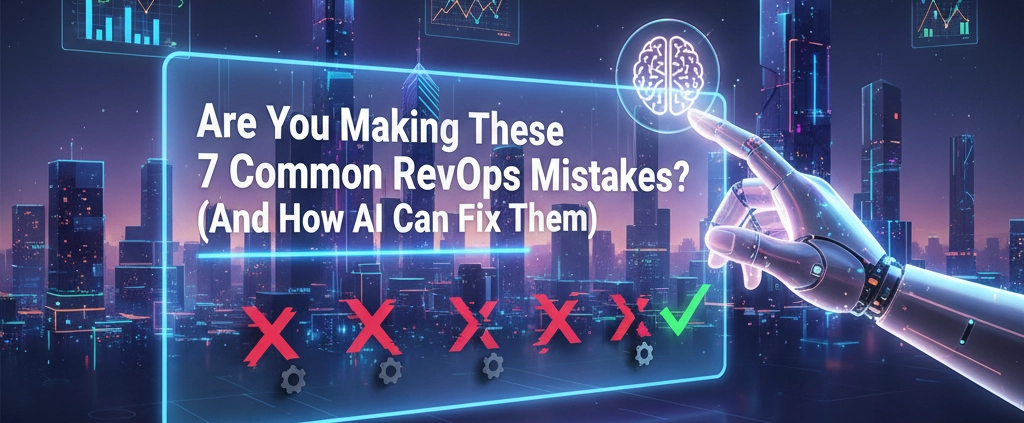Are You Making These 7 Common RevOps Mistakes? (And How AI Can Fix Them)
You know that feeling when your revenue operations feel like they're running on duct tape and good intentions? You're not alone. I've seen countless B2B SaaS companies struggle with the same RevOps pitfalls: and here's the thing: most of these mistakes aren't obvious until they're costing you serious money.
The good news? AI is finally mature enough to solve many of these problems automatically. Let's dive into the seven most common RevOps mistakes I see teams making, and more importantly, how you can use AI to fix them before they derail your growth.
Mistake #1: Treating RevOps Like a Junior Role (Instead of Strategic Leadership)
Here's a mistake I see all the time: companies assign RevOps to junior employees, interns, or Salesforce administrators without proper operations expertise. I get it: operations can feel like a cost center rather than a growth driver. But this approach backfires spectacularly.
When you put junior professionals in charge of RevOps, they either lack knowledge of best practices or lack the authority to challenge senior leadership decisions that could harm the business. It's like asking a chef to manage a farm: good intentions, wrong skillset.
How AI Fixes This: AI-powered analytics tools can help bridge the experience gap by providing automated insights and recommendations. Your junior RevOps person gets access to the same data-driven decision-making capabilities that would normally require years of experience to develop. Think of AI as training wheels that actually make you faster.

Mistake #2: Keeping Sales and Marketing Operations in Separate Silos
This one drives me crazy because it seems so logical on the surface. Sales Operations reports to sales, Marketing Operations reports to marketing: makes sense, right? Wrong.
Here's what actually happens: Sales and marketing leaders without operations expertise start providing well-intentioned but misguided direction to their ops teams. You end up with fragmented processes, inconsistent data, and teams that can't work together effectively.
How AI Fixes This: AI creates a single source of truth that transcends departmental boundaries. Instead of reorganizing your entire company structure, AI tools can unify your fragmented teams by providing consistent data and insights that everyone can work from. Your sales and marketing ops teams can finally speak the same language.
Mistake #3: Speaking Different Languages Across Teams
Speaking of language: this is where things get messy fast. Sales calls them "qualified leads," marketing calls them "MQLs," and customer success has their own terminology entirely. When stakeholders can't agree on basic definitions, every strategic initiative turns into a translation exercise.
I've watched companies spend months arguing about conversion rates simply because nobody defined what "conversion" meant. Meanwhile, competitors are eating their lunch.
How AI Fixes This: AI tools can standardize your data definitions and automatically translate between different departmental metrics. Instead of manually mapping "marketing qualified leads" to "sales accepted leads," AI handles the translation layer, ensuring consistent communication across all your teams.

Mistake #4: Asking the Wrong Questions (And Solving the Wrong Problems)
This mistake is subtle but deadly. Your RevOps team focuses on surface-level symptoms instead of root causes. For example, you notice a handover delay between marketing and sales, so you optimize the handover process. Problem solved, right?
Not if the real issue is that marketing's leads aren't relevant enough for sales to convert in the first place. You just optimized a broken process.
How AI Fixes This: AI-driven analytics excel at identifying hidden patterns and correlations in your revenue data. Instead of making assumptions about what's broken, AI helps you recognize when you're treating symptoms rather than diseases. You'll start asking better questions because you'll see the actual relationships in your data.
Mistake #5: Drowning in Tool Sprawl
Let me guess: your team uses HubSpot for CRM, Outreach for sequences, Calendly for scheduling, Typeform for surveys, and five other tools for things that your primary platform probably already does. Every startup justifies this by seeking specialized features, but they rarely leverage the capabilities already embedded in their main platforms.
Here's the reality: every additional tool introduces financial costs, integration complexity, and data silos. You're not optimizing: you're creating operational debt.
How AI Fixes This: AI can integrate your disparate systems and consolidate data from multiple tools, reducing the friction of maintaining a complex tech stack. More importantly, AI can help you identify which tools are actually necessary and which ones are just expensive redundancy. Think of it as Marie Kondo for your software stack.

Mistake #6: Burning Sales Time on Manual Data Entry
Here's a number that should make you angry: sales reps spend 18% of their time on CRM data entry instead of selling. That's almost one full day per week of your highest-paid employees doing administrative work.
The result? Incomplete records, inconsistent data quality, and sales teams that hate their CRM. Plus, poor data quality means any AI recommendations you do implement are built on shaky foundations.
How AI Fixes This: AI automation can capture and populate CRM data automatically from calls, emails, and meetings. Your sales team spends that 18% of their time actually selling, while AI ensures your data stays clean and complete. It's like having a dedicated data entry assistant for every rep.
Mistake #7: Blindly Trusting AI Recommendations
Here's the irony: as RevOps teams adopt AI (48% are already using generative AI), many make the mistake of trusting AI recommendations without critical review. If your AI model is trained solely on historical data showing past wins were primarily mid-market deals, it might deprioritize high-value enterprise opportunities.
You're essentially letting your past limitations define your future potential.
How AI Fixes This: The solution isn't less AI: it's smarter AI implementation. Use AI as a decision-support tool, not a replacement for human judgment. Scrutinize AI recommendations against your business strategy, market opportunities, and organizational goals. Think of AI as your most data-savvy advisor, not as an oracle that determines strategy.

The Bottom Line: AI Is Your RevOps Force Multiplier
The most successful RevOps teams I work with avoid these mistakes by combining three things: experienced operations leadership, unified team structures, and thoughtful AI implementation. They don't use AI to replace human judgment: they use it to amplify human intelligence.
Your RevOps foundation needs to be solid before AI can work its magic. But once you've got the basics right, AI becomes your force multiplier. It handles the repetitive work, surfaces the insights you'd miss, and helps your team focus on strategy instead of spreadsheets.
If you're making any of these mistakes, you're not alone: but you don't have to stay stuck. The combination of proper organizational structure, quality data discipline, and strategic AI implementation creates the foundation for sustainable revenue growth.
Ready to stop making these mistakes? Let's talk about how AI can transform your revenue operations from a cost center into a growth engine.



